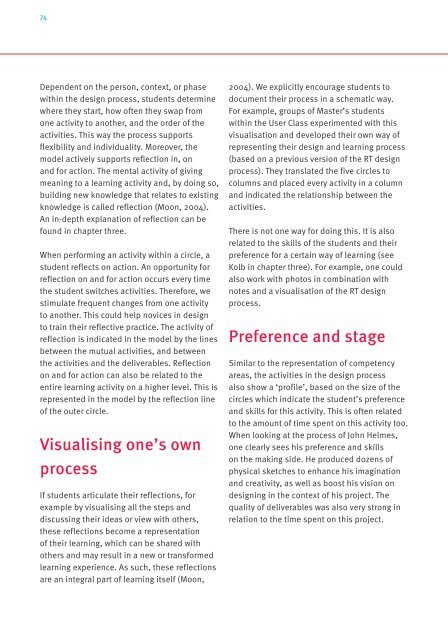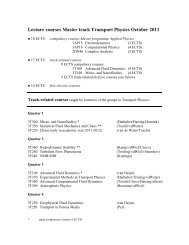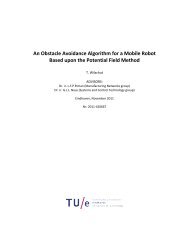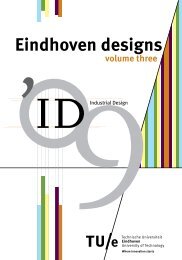Education guide 'Eindhoven designs' - Technische Universiteit ...
Education guide 'Eindhoven designs' - Technische Universiteit ...
Education guide 'Eindhoven designs' - Technische Universiteit ...
Create successful ePaper yourself
Turn your PDF publications into a flip-book with our unique Google optimized e-Paper software.
74<br />
Dependent on the person, context, or phase<br />
within the design process, students determine<br />
where they start, how often they swap from<br />
one activity to another, and the order of the<br />
activities. This way the process supports<br />
flexibility and individuality. Moreover, the<br />
model actively supports reflection in, on<br />
and for action. The mental activity of giving<br />
meaning to a learning activity and, by doing so,<br />
building new knowledge that relates to existing<br />
knowledge is called reflection (Moon, 2004).<br />
An in-depth explanation of reflection can be<br />
found in chapter three.<br />
When performing an activity within a circle, a<br />
student reflects on action. An opportunity for<br />
reflection on and for action occurs every time<br />
the student switches activities. Therefore, we<br />
stimulate frequent changes from one activity<br />
to another. This could help novices in design<br />
to train their reflective practice. The activity of<br />
reflection is indicated in the model by the lines<br />
between the mutual activities, and between<br />
the activities and the deliverables. Reflection<br />
on and for action can also be related to the<br />
entire learning activity on a higher level. This is<br />
represented in the model by the reflection line<br />
of the outer circle.<br />
Visualising one’s own<br />
process<br />
If students articulate their reflections, for<br />
example by visualising all the steps and<br />
discussing their ideas or view with others,<br />
these reflections become a representation<br />
of their learning, which can be shared with<br />
others and may result in a new or transformed<br />
learning experience. As such, these reflections<br />
are an integral part of learning itself (Moon,<br />
2004). We explicitly encourage students to<br />
document their process in a schematic way.<br />
For example, groups of Master’s students<br />
within the User Class experimented with this<br />
visualisation and developed their own way of<br />
representing their design and learning process<br />
(based on a previous version of the RT design<br />
process). They translated the five circles to<br />
columns and placed every activity in a column<br />
and indicated the relationship between the<br />
activities.<br />
There is not one way for doing this. It is also<br />
related to the skills of the students and their<br />
preference for a certain way of learning (see<br />
Kolb in chapter three). For example, one could<br />
also work with photos in combination with<br />
notes and a visualisation of the RT design<br />
process.<br />
Preference and stage<br />
Similar to the representation of competency<br />
areas, the activities in the design process<br />
also show a ‘profile’, based on the size of the<br />
circles which indicate the student’s preference<br />
and skills for this activity. This is often related<br />
to the amount of time spent on this activity too.<br />
When looking at the process of John Helmes,<br />
one clearly sees his preference and skills<br />
on the making side. He produced dozens of<br />
physical sketches to enhance his imagination<br />
and creativity, as well as boost his vision on<br />
designing in the context of his project. The<br />
quality of deliverables was also very strong in<br />
relation to the time spent on this project.

















